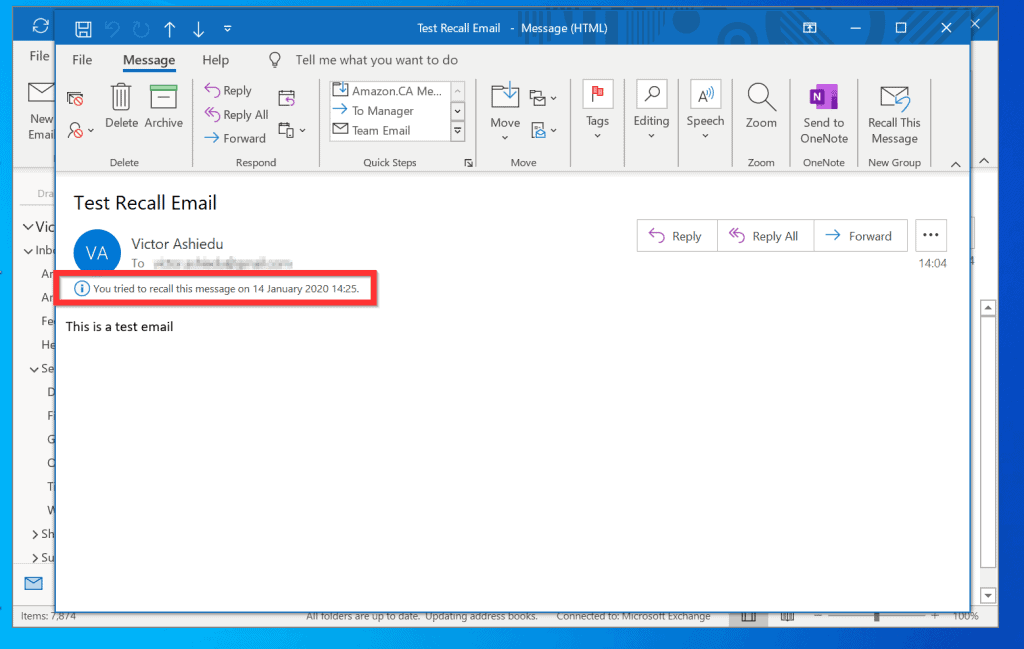

Here are a few reasons why Outlook email recall could have failed despite meeting all the key requirements: If these conditions apply to you, then your recall attempt could have failed due to different factors that may or may not be in your control. If the recipient opens the recall message first, the original message gets deleted and he or she is notified that you have deleted the message from their mailbox.įirstly, make sure that you’re meeting all the conditions for Outlook recall to work i.e., both you and your recipient must be on an Exchange server within the same organisation and using Outlook as the email client.If the recipient opens the original message first, the recall fails and he or she can view both the old and new messages.The recipient has set a rule or filter that moves the original message and the recall message from the inbox to another folder. Please note that in all the scenarios the recipient will receive both the original message and recall message. Listed below are different scenarios that determine the potential success or failure of an Outlook recall after you have sent a message to someone and then, recalled the original message and replaced it with a new one. What happens after you have given the command to recall or replace a message in Outlook depends on the recipient’s settings. ( Note: If the message is opened in the reading pane, you won’t be allowed to recall it) Compose your new email and then click the Send button If you have selected the replace option, Outlook will open a new window for you to revise the message. In case you have selected the recall-only option, your job is done here.Check the box that says “Tell me if the recall succeeds or fails for each recipient”.On the pop-up window that appears, select one of the two options: “ Delete unread copies of this message” to recall the message, “ Delete unread copies and replace with a new message” to replace the sent message with a new one.If you’re using the Simplified version, click on the three dots (…) at the end of the toolbar, go to Actions and then select Recall This Message If you have the Classic Ribbon, click on Actions and from the drop-down menu, select Recall This Message.Select the Message tab at the top of the window.Double-click on the message you want to recall to open it in a new window.Go to the Sent Items folder on the left sidebar of your Outlook inbox.With the check box ticked, you would get an email with the report of the status of the recall.Keep the highlighted check box ticked to know the status of the recall.Select the Delete unread copies of this message option from the two radio buttons.Once you click on Recall This Message, a dialogue box like the one below would appear.Note: You will not be able to recall sent emails on the web version of outlook. Classic Ribbon View: Click on Actions > Recall This Message.Then, click on Actions > Recall This Message. Simplified Ribbon View: Click on the Three dots icon (.) towards the extreme right of the screen.These ribbons change the view of the task bar that you see at the top of your email. Outlook gives you two ribbons to choose from, Classic Ribbon and Simplified Ribbon. The recall feature would not be visible in that mode. Note: Just single clicking on the email will open the email in preview mode. Locate the Sent Items folder from the folder pane of the outlook window.ĭouble click on the Email that you want to recall so that it opens in a new window.

For example, if a message is sent to or from Gmail/Hotmail, you would not be able to recall it. Also, both the sender and the receiver should have a Microsoft 365 or Microsoft Exchange account in the same organization. Note: This feature is available only after the email has been sent. Have you ever realized that you made a grammatical error in your email or that you missed including important information in it right after you hit the Send button? Microsoft’s Recall Email feature is here to save the day! With this feature, you can retrieve an email from the mailboxes of recipients who are yet to open the email. This article contains information on the Recall Email feature of Microsoft Outlook.


 0 kommentar(er)
0 kommentar(er)
